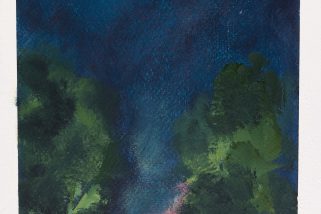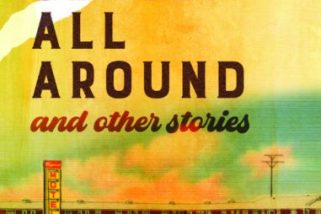
“Re-interpreting the Carved Revenge on Your Own Back” by Shauna Osborn
In the White Tigers section of The Woman Warrior, we bear witness to a short-lived family reunion before our warrior heads off to battle. Her parents carve oaths on her back, making her body a text where genealogical memory is visible and an emotional connection to the family’s interests are made physical: “Wherever you go, whatever happens to you, people will know our sacrifice,” said the mother. “And you’ll never forget either,” (41).
The female body is a most exploited target—physically, mentally, culturally, and economically. From the moment of birth, a body is named and mired with social crisis. To confront the female body is to confront not only an individual’s abuse but also the abuse of women’s bodies throughout history. Our bodies are subjected to legislation that goes against our well-being. They are common sites of physical and sexual abuse, are paid less for work, and are objectified to sell everything from ab machines to zoo memberships. We are told our bodies are failures if we do not embody unrealistic standards of beauty starting when we are infants. We are taught to hate, abuse, and/or fear our own bodies early.
In “The Laugh of the Medusa,” Helen Cixous suggests that if women are forced to remain in their bodies, then they can do one of two things: 1) remain trapped inside that body or 2) use the body as a medium of communication.
“By writing her self, woman will return to the body which has been more than confiscated from her… Censor the body and you censor breath and speech at the same time.” (880)
When you have ownership of your own body, the world is a drastically different place. As feminist creators, our projects help us to reclaim our voice—to reclaim our own bodies. A woman without her body cannot be as powerful as one that knows herself.
Kingston’s woman warrior spent fifteen years learning how to use her body. She could not be a great warrior unless she had connection to her muscles, reflexes, and the strength within her flesh. She finally gained this knowledge and her autonomy to be abruptly reminded that she is not the only one who feels an ownership of her skin, her body. She belongs to a family, to a lineage, to a community, to a country. She is one specific part in a larger whole. The project of knowing her body and gaining battle prowess were not completed in a vacuum. What is the point of becoming a great warrior if there are no battles to fight? She did not learn these skills just to protect herself. She learned them to defend her community, which is the purpose of all great warriors. The woman warrior’s parents carved oaths and names into her back so she will never forget her connections again. Once the carving is over, the woman warrior says, “I saw my back covered entirely with words in red and black files, like an army, like my army,” (42). Her connections to the world, those grievances on her back, add to her strength.
A woman’s body is a physical text—our families, lovers, and communities carving into our flesh whatever they wish for us to remember when we head into battle. What messages were carved on your back? Do they add to your strength?
I am a product of warring tribes from different continents. My mother’s people are from the Comanche Nation. My father is from Franconians and Bavarians of Germany. Two extremely different battle strategies and cultures brought together as one with my birth. Both sides brutal, both full of survivors. Growing up, my parents claimed that the Comanche/German temperament could be the world’s undoing. That it was a gift, a weapon their children would have to learn how to wield appropriately. There are several family members who did not wield their parts of this temperament with any skill—my parents among them. The battles they fight, the revenge they sought, are of little interest to me. The messages they carved on my skin are not my strength. They are only scars.
A snake sheds its skin as it grows. We go through a similar process–restructuring old, artificial and outgrown forms of self in order to heal and restore what is true within our nature. Yet, deep scars rarely heal to be invisible. There is always a faint reminder of the damage we have endured. Can you spot someone else’s scars? Are they celebrated as trophies from the battles survived? Are they beautiful or hideous?
Awam Amkpa writes in “A State of Perpetual Becoming,”
Your body is a social text. It is spoken for by the legal infrastructures of society… In a highly socialized space, what then happens …is a hyper-consciousness of the textuality of these bodies and a consciousness about breaking down those bodies so that in their fragmented mode, they actually express their opposition to domination.
How do you fragment your body? How do you use those fragments as part of your battle strategies? What are the ways we can piece ourselves together again? What should we carve into our skins to remind ourselves?
Works Cited
Amkpa, Awam. “A State of Perpetual Becoming: African Bodies as Texts, Methods, and Archives.” Dance Research Journal, Volume 42, Number 1. (Summer, 2010). pp. 83-88. Print.
Cixous, Hélène; Cohen, Keith; and Cohen, Paula. “The Laugh of the Medusa.” Signs, Vol. 1, No. 4. (Summer, 1976), pp. 875-893. Print.
Hong Kingston, Maxine. “White Tigers.” The Women Warrior: Memoirs of Girlhood Among Ghosts. Vintage Books Edition. New York. 1977. pp. 23-63. Print.
____________________
Share your response to this work, in any form, here

Shauna Osborn Artist Statement:
As a member of the Yapaituka band of the Numunuu, Shauna creates contemporary work in their tribal language, funds tribal development and language immersion opportunities through grant writing, and creates Indigenous literary projects. Their debut poetry collection is Arachnid Verve (Mongrel Empire Press, 2016).






